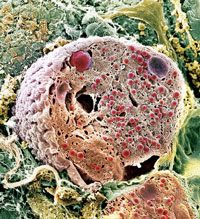Publication
Article
Oncology Live®
Chasing a Breakthrough in Cancer Cell Signaling: An Interview With William G. Cance, MD
Author(s):
In 1993, William G. Cance, MD, was the first researcher to clone human focal adhesion kinase (FAK) and demonstrate its overexpression in metastatic cancers.

In 1993, William G. Cance, MD, was the first researcher to clone human focal adhesion kinase (FAK) and demonstrate its overexpression in metastatic cancers.
Today, Cance is the chief scientific officer of CureFAKtor Pharmaceuticals, LLC, a privately held biopharmaceutical company that he founded 3 years ago. The company conducts its research at the Roswell Park Cancer Institute in Buffalo, New York, where Cance is chair of Surgical Oncology, surgeon-in-chief, and a co-leader of the Program in Drug Discovery and Experimental Therapeutics.
CureFAKtor is perched on the edge of what its scientists believe may be a significant breakthrough in targeted cancer treatment. In January, the company presented preclinical research at the 2011 Gastrointestinal Cancers Symposium in San Francisco, California, that showed its lead compound helped reduce the size of malignant pancreatic tumors by up to 80%.
The company’s first target is pancreatic cancer, which is the fourthleading cause of cancer deaths overall and among the most vicious forms of the disease. Only 7% of cases are diagnosed at an early stage and the prognosis is grim even for those patients with local disease, according to the American Cancer Society. The relative 1-year survival rate for all stages combined is 25%; the 5-year rate is 6%.
Here, Cance discusses the developing technology and its potential.
OncLive: Please describe the role that FAK inhibitors would play in the treatment of cancer?
Cance: FAK has emerged as a critically important target for cancer therapeutics. CureFAKtor Pharmaceuticals scientists first discovered FAK in human tumors approximately 20 years ago. FAK is massively overexpressed in virtually all solid tumors and it functions as a survival signal for cancer cells as they invade and metastasize.
In simple terms, FAK is much like a “force field” that cocoons cancer cells to allow them to survive the effects of chemotherapy, radiation therapy, and other natural processes designed to execute aberrant cancer cells. One way that FAK performs its survival function is by sequestering key pro—apoptotic proteins that are designed to execute aberrant cells, such as p53, receptor–interacting protein (RIP), and neurofibromin.
FAK functions as both a tyrosine kinase, as well as a docking station by virtue of its long amino terminal and carboxy—terminal domains. Numerous oncogenic molecules bind to FAK, including human epidermal growth factor receptor 1 (HER1), HER2, p53, Src, and vascular endothelial growth factor receptor 3 (VEGFR3).
CureFAKtor has a broad-based technology designed to disrupt these protein—protein interactions. The company is a world leader in the development of allosteric FAK inhibitors for use as cancer therapeutics and has a deep pipeline of these drugs.

CureFAKtor’s current compound, CFAK-C4, inhibits the binding of VEGFR3 to FAK. We have shown that this oral small—molecule drug has efficacy as a single agent, but more importantly, synergizes with chemotherapy in a number of different solid tumors. CureFAKtor was recently granted FDA orphan drug designation for the use of CFAK-C4 plus gemcitabine to treat pancreatic cancer.
The research presented at the 2011 Gastrointestinal Cancers Symposium1 described dramatic results in a preclinical study. Please elaborate.
Preclinical results showed dramatic efficacy in models of human pancreatic cancer that were presented at the 2011 Gastrointestinal Cancers Symposium. The results demonstrated that FAK inhibitors targeting the binding site of VEGFR3 reduced the growth of pancreatic cancer cells in vitro and in vivo.
The preclinical research found that CureFAKtor’s lead compound, CFAK-C4, reduced tumor growth in vivo in mouse pancreatic cancer cells by up to 60%, and CFAK-C4 combined with the chemotherapy drug gemcitabine had a synergistic effect and led to 80% pancreatic cancer tumor reduction. The study also found that CFAK-C4 combined with gemcitabine had a prolonged effect on pancreatic tumor growth. Two weeks after treatment, the tumor size in the previously treated group was approximately 75% smaller than the tumor in the control group.
Please elaborate upon the research methods used thus far to investigate CFAK-C4.
Computer modeling was the initial step in the selection of small molecules targeted to the binding site of VEGFR3 on FAK, which was followed by the analysis of selected compounds in multiple in vitro assays and in vivo mouse models of xenograft and orthotopic tumors.
What are the next steps for CFAK-C4 in terms of research?
We plan to broaden the preclinical models for additional indications such as colon, lung, and brain tumors.
Is there a projected date for an FDA filing for a new drug application?
We are currently pursuing investigational new drug status for CFAK-C4 and plan to be in phase I clinical trials in 2012.
What are the company’s plans to develop CFAK-C4 as platform technology?
A second allosteric FAK inhibitor is CFAK-Y15. This FAK inhibitor effectively abrogates FAK kinase activity by binding to its active tyrosine-397 site. In addition, CFAK-Y15 is a Src inhibitor, preventing binding of proteins that contain SH-2 domains to this site of FAK. This drug has efficacy in a variety of preclinical models of cancer.
CureFAKtor has a broad-based platform technology with over 40 compounds in its pipeline for treatment of solid tumors targeting pancreatic, breast, colon, melanoma, lung, and brain cancers. These represent allosteric inhibitors to a number of significant protein—protein interactions of FAK.
While these demonstrate efficacy as individual agents, we believe that ultimately combinations of these compounds will prove especially useful.
What are the technological advances that have made the development of the compound possible?
Knowledge of 3D structure of the proteins, which is achieved through crystallographic studies and computer modeling with the use of a supercomputer allowing fast selection of the best compounds fitted to the targeted site.
How has CureFAKtor been able to assemble the resources needed to get to this stage?
Over $15 million for CureFAKtor has been provided by the National Institutes of Health, and this work has been continuously funded since 1992. Further funding for CureFAKtor drug development has been provided through private investors.
What are the major challenges you and your company have faced thus far in developing this technology? What challenges loom in the future?
Over the years of research we have faced and overcome many challenges typical of groundbreaking research of this kind, including skepticism from the scientific community on targeting protein—protein interactions, which we have conclusively proven we can do. Our future challenge is taking the various compounds in our pipeline to human trial.
REFERENCE 1. Kurenova E, Liau J, He D-H, et al. Effect of a novel FAK inhibitor targeted to the binding site of VEGFR3 on pancreatic cancer proliferation in vitro and in vivo. Presented at: 2011 Gastrointestinal Cancers Symposium; January 20-22, 2011; San Francisco, CA.










